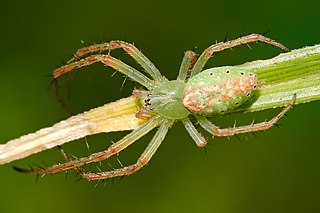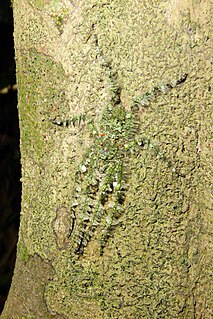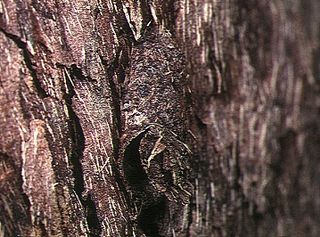
Gasteracantha is a genus of orb-weaver spiders first named by Carl Jakob Sundevall in 1833. The females of most species are brightly colored with six prominent spines on their broad, hardened, shell-like abdomens. The name Gasteracantha is derived from the Greek gaster (γαστήρ), meaning "belly, abdomen", and akantha (άκανθα), meaning "thorn, spine". Spiny-backed orb-weavers are sometimes colloquially called "crab spiders" because of their shape, but they are not closely related to the true crab spiders. Other colloquial names for certain species include thorn spider, star spider, kite spider, or jewel spider.
Chalcolecta is a spider genus of the jumping spider family, Salticidae.
Cocalodes is a genus of jumping spiders that was first described by Reginald Innes Pocock in 1897. The name is an alteration of the salticid genus Cocalus.
Colyttus is a genus of Asian jumping spiders that was first described by Tamerlan Thorell in 1891. It is named for the Latin word for "with two stripes". C. lehtinen is named in honor of Finnish arachnologist Pekka T. Lehtinen.
Omoedus is a genus of jumping spiders.

Opisthoncus is a genus of South Pacific jumping spiders that was first described by Ludwig Carl Christian Koch in 1880. There are still many Australian species that have not yet been described.

Plexippus is a genus of jumping spiders that was first described by Carl Ludwig Koch in 1846. It is considered a senior synonym of Hissarinus and Apamamia.
Pristobaeus is a genus of jumping spiders that was first described by Eugène Louis Simon in 1902.

Sandalodes is a genus of jumping spiders that was first described by Eugen von Keyserling in 1883. S. scopifer, a black spider with white markings, is a common species in eucalypt forests on the Darling Downs.

Simaetha is a genus of Australasian jumping spiders that was first described by Tamerlan Thorell in 1881. They resemble members of Simaethula and Stertinius.

Telamonia is a genus of jumping spiders that was first described by Tamerlan Thorell in 1887. They are colorful spiders, with patterns that vary considerably between sexes and species. Two longitudinal stripes along the abdomen are common, and the carapace is often colored. They have a slender opisthosoma and long legs.
Thorelliola is a genus of jumping spiders that was first described by Embrik Strand in 1942. It is named after arachnologist Tamerlan Thorell.

Zenodorus is a genus of the jumping spiders distributed from the Moluccas to Australia, including several islands of the Pacific. It was once considered a junior synonym of Omoedus, but this was later rejected by Jerzy Prószyński in 2017. At least one species, Z. orbiculatus, specializes on hunting ants.

Selenocosmia is a genus of tarantulas that was first described by Anton Ausserer in 1871.

Cyrtophora, the tent-web spiders, is a genus of orb-weaver spiders first described by Eugène Simon in 1895. Although they are in the "orb weaver" family, they do not build orb webs. Their tent-like, highly complex non-sticky web is sometimes considered a precursor of the simplified orb web. These webs are aligned horizontally, with a network of supporting threads above them. These spiders often live in colonies. Females have a body length of mostly about 10 millimetres (0.39 in) long. Some members, including Cyrtophora cicatrosa, exhibit the ability to change colour rapidly.

Ohilimia is a spider genus of the jumping spider family, Salticidae.

Pandercetes is a genus of huntsman spiders that was first described by Ludwig Carl Christian Koch in his 1875 treatise on Australian spiders. They are mainly distributed in tropical Asia and Australia, and are known for their cryptic coloration that matches local moss and lichen. Their legs have lateral hairs, giving them a feathery appearance, further masking their outline against tree trunks. Their head is somewhat elevated and the carapace has the thoracic region low and flat.
Matidia is a genus of southeast Asian sac spiders first described by Tamerlan Thorell in 1878.

Conothele is a genus of mygalomorph spiders in the family Halonoproctidae, first described by Tamerlan Thorell in 1878. Originally placed with the Ctenizidae, it was moved to the Halonoproctidae in 2018.












